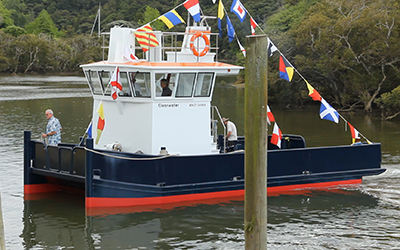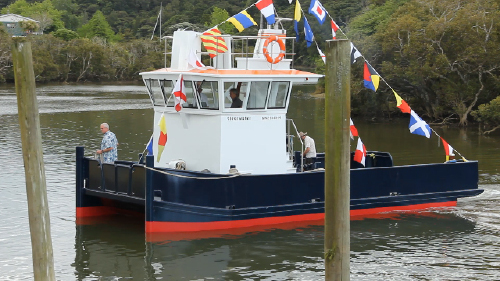Yes to shift a few tons of this earthly delight


Daughter of Champion Son of a Champion: The dredge tugboat Clearwater, the creation of champion of the Mahurangi River, Peter Thompson, son of champion of the Mahurangi River, Claude Thompson. image Majorlook Productions
Navigator, navigator rise up and be strong
The morning is here and there’s work to be done.
Take your pick and your shovel and the bold dynamite
For to shift a few tons of this earthly delight
Yes to shift a few tons of this earthly delight.Chorus of Philip Gaston’s anthem to the Irish navvies who built England’s navigation canals
The dream of dredging the Mahurangi River to restore its navigability fills some with hope, some with dread.
The vast majority would welcome it, but only if it could be accomplished without further despoiling the already severely stressed benthic environment, and if the dredgings can do good wherever they are deposited.
Traditionally, dredgings were taken some way out to sea, and dumped. Out of sightCuvier Island is almost literally out of sight, being only visible from the scenic ridge road at Mahurangi West in exceptionally clear atmospheric conditions, out of mind, but at a dreadful cost to the benthic communities directly smothered or otherwise suffocated by the spreading sediment plume.
Over the years, Auckland’s dumping site was chased farther and farther out to sea. Today the dumping site is beyond Cuvier Island—a staggering insult, even by Kiwi standards, to the naturalist who was one of Darwin’s ‘gods’.
It is improbable that the community, as concerned as it is about the navigability of the Mahurangi River, would countenance the dumping of its sediment at sea, legal as that potentially might be. Ports of Auckland has found that mixing dredgings with cement to make mudcrete for the Fergusson container terminal reclamation is a more cost effective and environmentally friendly sell than dumping at sea.
Rodney District Council has made a preliminary study of potential deposition sites, all but one being in the intertidal zone, in the upper harbour and river. The challenge is to locate a site that is not just tolerated by the community, but wholeheartedly embraced because of some wholesome and attractive end use for the area. This may prove to be one of the four intertidal sites, the one non-marine (lime works) site, or some as yet unidentified site.
For several years, Mahurangi River champion Peter Thompson has been canvassing a concept where the community would contribute to the infrastructure that would enable a dredging programme to begin. Mahurangi marine farmers, meantime, see an opportunity to use the same infrastructure to clean up a thousand tonnes of material from derelict oyster leases—the failure to address over decades being a source of considerable frustration with adjoining property holders.
The revival of the scow Jane Gifford has brought the need for dredging into sharp relief. Her ability to operate from the Mahurangi River is currently severely curtailed, and with it her potential role as an environmental class room for, potentially, generations of school children from Mahurangi and further afield.
Community discussion is now focussing on the need to establish a navigation trust to drive the programme. Such trusts exist worldwide, with many in the United Kingdom devoted to the restoration and operation of 1700s navigation canals. Thus, the title Mahurangi Navigation Trust would appear inescapable.
Those discussing the concept are acutely aware that without the community’s wholehearted involvement and support, the Mahurangi Navigation Trust will not get…
to shift few tons of this earthly delight.

Always a pleasure to read your articles and I came across this one recently. There is funding in the 2012 Annual Plan for this dredging to be done (this is carried over from the 2011 budgets). However as far as I am aware there has yet to be a decision made on exactly when this will be done, by whom and where the dredging spoil will be deposited. I agree with you that disposal at sea is a poor option on many levels and would hope that agreement and necessary consents can be obtained to use them for some more functional and civic purpose. It has been mentioned that a possible site for the dredging spoil to be utilised may be adjacent to the landing at Dawsons Creek. I have been told that there is a precedent in this space somewhere, it is relatively close and quite accessible. To be able to develop a site that provides safe and convenient access to the Mahurangi River not too far from Warkworth might then open other opportunities and provide an inviting and attractive destination for the walking trail that starts on the Goodall Reserve. It seems incongruous that the cost of transport has the potential to completely stymie the effectiveness of a process like clearing this river and I certainly hope that the community is able to come to some agreement on the most appropriate method and site for the dispersal of spoil. It is extremely important to get the best bang for our collective buck while ensuring that the nature and quality of our environment is not compromised. I do look forward to the river being dredged and am certain that it will encourage more users to make the trip up the river and appreciate the magnificence of this part of our coast.